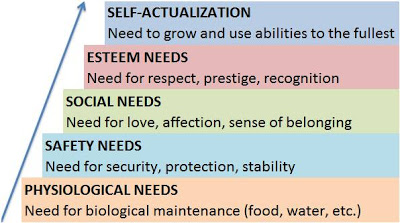Abraham Maslow proposed a theory in psychology, which is popularly known as "Maslow's Hierarchy of Needs". One of the many interesting things Maslow noticed was that some needs take precedence over others.
He laid out five broader layers of needs: the physiological needs, the needs for safety and security, the needs for love and belonging, the needs for esteem, and the need to actualize the self, in that order.
He laid out five broader layers of needs: the physiological needs, the needs for safety and security, the needs for love and belonging, the needs for esteem, and the need to actualize the self, in that order.
Deficit Needs and Being Needs
Maslow's hierarchy of needs is often portrayed in the shape of a pyramid, with the largest and most fundamental levels of needs at the bottom, and the need for self-actualization at the top. Maslow calls the bottom four levels as deficit needs, or D-needs. He has called the top layer as being needs or B-needs.

|
| Maslow's Hierarchy of Needs |
Needs identified in Maslow's Hierarchy
Physiological needs are obvious; they are the literal requirements for human survival. If these requirements are not met, people will not be interested in any higher order needs like social needs or esteem needs.When the physiological needs are largely taken care of, the second layer of needs (Safety Needs) comes into play. You will become increasingly interested in finding safe circumstances, stability, protection; the individual's safety needs take precedence and dominate behaviour.
After physiological and safety needs are fulfilled, the third layer of human needs are social needs and involve feelings of belongingness. The individual begins to feel the need for friends, family, relationships and a sense of community.
Next, we begin to look for self-esteem. Esteem presents the normal human desire to be accepted and valued by others.
The last level of need is Self-actualization. This level of need pertains to what a person's full potential is and realizing that potential.
You may also be interested in:
As a project manager, it is important to understand Maslow's hierarchy of needs. Maslow's theory suggests that the most basic level of needs must be met before the individual will strongly desire the secondary or higher level needs. This concept is important in managing and developing human resources in an organization.


